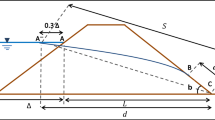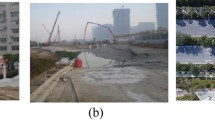Abstract
Longitudinal erosion is the main mechanism of the overtopping breaching of dams. Although this type of erosion has been studied by conducting flume model tests, there are no experimental studies on the longitudinal erosion of concrete-face sand-gravel dams (CFSGDs). In this study, flume model tests were conducted to analyze the overtopping breaching of a CFSGD. Based on monitoring data recorded by pore water pressure sensors, measuring rods, and high-definition cameras, the longitudinal erosion process of the CFSGD was analyzed, and the influence of joint water stop failure on the longitudinal erosion process was studied. The results showed that the scour pit and the central mound area were the most evident erosion characteristics, similar to that observed in an actual breaching process. A longitudinal evolution model was proposed, which reflects the erosion characteristics of the CFSGD at different stages. The longitudinal erosion rate and undercutting erosion rate were found to first increase and then decrease. The joint water stop failure did not change the longitudinal erosion characteristics; however, the seepage reduced the shear strength of the soil, and the dam breaching duration was 1.53 times that observed in the intact water stop case. Through a force analysis of the soil particles on the seepage surface, the critical angle (θcr) for erosion failure on the seepage surface was determined, and a formula for the critical shear stress (τc) of the soil particles under the action of seepage and overflow was derived.

















Similar content being viewed by others
Data availability
All data used in this study are available from the corresponding author on request.
References
Awal R, Nakagawa H, Kawaike K, Baba Y, Zhang H (2008) Experimental study on prediction of failure mode of landslide dams. 4th International Conference on Scour and Erosion (ICSE-4). November 5–7, Tokyo, Japan, pp 655–660
Chang DS, Zhang LM (2010) Simulation of the erosion process of landslide dams due to overtopping considering variations in soil erodibility along depth. Nat Hazard Earth Sys 10(4):933–946. https://doi.org/10.5194/nhess-10-933-2010
Chang DS, Zhang LM, Xu Y, Huang RQ (2011) Field testing of erodibility of two landslide dams triggered by the 12 May Wenchuan earthquake. Landslides 8(3):321–332. https://doi.org/10.1007/s10346-011-0256-x
Chen SS, Zhong QM, Cao W (2011) Centrifugal model test and numerical simulation of the breaching process of clay core dams due to overtopping. Adv Water Sci 22(5):674–679. https://doi.org/10.1002/clc.20818
Chen SS, Zhong QM, Cao W (2012) Breach mechanism and numerical simulation for seepage failure of earth-rock dams. Sci China Technol Sci 55(6):1757–1764. https://doi.org/10.1007/s11431-012-4768-y
Cheng NS, Chiew YM (1999) Incipient sediment motion with upward seepage. J Hydraul Res 37(5):665–681. https://doi.org/10.1080/00221689909498522
Coleman SE, Andrews DP, Webby MG (2002) Overtopping breaching of noncohesive homogeneous embankments. J Hydraul Eng 128(9):829–838. https://doi.org/10.1061/(asce)0733-9429(2002)128:9(829)
Cui YF, Zhou XJ, Guo CX (2017) Experimental study on the moving characteristics of fine grains in wide grading unconsolidated soil under heavy rainfall. J Mount Sci 14(3):417–431. https://doi.org/10.1007/s11629-016-4303-x
Feliciano Cestero JA, Imran J, Chaudhry MH (2015) Experimental investigation of the effects of soil properties on levee breach by overtopping. J Hydraul Eng 141(4):04014085. https://doi.org/10.1061/(ASCE)HY.1943-7900.0000964
Gregoretti C, Maltauro A, Lanzoni S (2010) Laboratory experiments on the failure of coarse homogeneous sediment natural dams on a sloping bed. J Hydraul Eng 136(11):868–879. https://doi.org/10.1061/(asce)hy.1943-7900.0000259
Gurbuz A, Peker I (2016) Monitored performance of a concrete-faced sand-gravel dam. J Perform Constr Fac 30(5):04016011. https://doi.org/10.1061/(ASCE)CF.1943-5509.0000870
Hanson GJ, Cook KR, Hunt SL (2005) Physical modeling of overtopping erosion and breach formation of cohesive embankments. T ASAE 48(5):1783–1794. https://doi.org/10.13031/2013.20012
Jewel AH, Fujisawa K, Murakami A (2019) Effect of seepage flow on incipient motion of sand particles in a bed subjected to surface flow. J Hydrol 579:124178. https://doi.org/10.1016/j.jhydrol.2019.124178
Jiang XG, Cui P, Chen HY, Guo YY (2017) Formation conditions of outburst debris flow triggered by overtopped natural dam failure. Landslides 14(3):821–831. https://doi.org/10.1007/s10346-016-0751-1
Jiang XG, Huang JH, Wei YW, Niu ZP, Chen FH, Zou ZY, Zhu ZY (2018) The influence of materials on the breaching process of natural dams. Landslides 15(2):243–255. https://doi.org/10.1007/s10346-017-0877-9
Jiang XG, Wei YW, Wu L, Hu KH, Zhu ZY, Zou ZY, Xiao WM (2019) Laboratory experiments on failure characteristics of non-cohesive sediment natural dam in progressive failure mode. Environmental Earth Sciences 78(17):1–14. https://doi.org/10.1007/s12665-019-8544-1
Kakinuma T, Shimizu Y (2014) Large-scale experiment and numerical modeling of a riverine levee breach. J Hydraul Eng 140(9):04014039. https://doi.org/10.1061/(ASCE)HY.1943-7900.0000902
Li LL, Li J, Yu RC (2020) Characteristics of summer regional rainfall events over Ili River Valley in Northwest China. Atmos Res 243:104996. https://doi.org/10.1016/j.atmosres.2020.104996
Li YL, Qiu W, Chen ZY, Wen LF, Wang L (2021) Experimental study on the process of overtopping breach of concrete-faced sand-gravel dam. Eur J Environ Civ En 26(13):6334–6353. https://doi.org/10.1080/19648189.2021.1939791
Ma HQ, Chi FD (2016) Technical progress on researches for the safety of high concrete-faced rockfill dams. Engineering 2(3):332–339. https://doi.org/10.1016/J.ENG.2016.03.010
Morris MW, Hassan MAAM, Vaskinn KA (2007) Breach formation: field test and laboratory experiments. J Hydraul Res 45(S1):9–17. https://doi.org/10.1080/00221686.2007.9521828
Papanicolaou AN, Diplas P, Evaggelopoulos N, Fotopoulos S (2002) Stochastic incipient motion criterion for spheres under various bed packing conditions. J Hydraul Eng 128(4):369–380. https://doi.org/10.1061/(ASCE)0733-9429(2002)128:4(369)
Pickert G, Weitbrecht V, Bieberstein A (2011) Breaching of overtopped river embankments controlled by apparent cohesion. J Hydraul Res 49(2):143–156. https://doi.org/10.1080/00221686.2011.552468
Qin RY, Wang CH (1996) Movement theory and its application of bed load sediment in river. China Railway Publishing House, Beijing (in Chinese)
Rogers JD, Watkins CM, Chung JW (2010) The 2005 Upper Taum Sauk dam failure: a case history. Environ Eng Geosci 16(3):257–289. https://doi.org/10.2113/gseegeosci.16.3.257
Sadeghi S, Hakimzadeh H, Babaeian Amini A (2020) Experimental investigation into outflow hydrographs of nonhomogeneous earth dam breaching due to overtopping. J Hydraul Eng 146(1):04019049. https://doi.org/10.1061/(ASCE)HY.1943-7900.0001664
Vallejo LE, Mawby R (2000) Porosity influence on the shear strength of granular material-clay mixtures. Eng Geol 58(2):125–136. https://doi.org/10.1016/s0013-7952(00)00051-x
Wang YQ, Xu D, He ZG, Wu WM (2020) Experimental study on sand dike breaching by wave overtopping. Appl Ocean Res 101:102195. https://doi.org/10.1016/j.apor.2020.102195
Xie LQ, Lei HJ, Yu YZ, Sun X (2009) Incipient motion of riverbank sediments with outflow seepage. J Hydraul Eng 135(3):228–233. https://doi.org/10.1061/(ASCE)0733-9429(2009)135:3(228)
Xu Y, Zhang LM (2009) Breaching parameters for earth and rockfill dams. J Geotech Geoenviron 135(12):1957–1970. https://doi.org/10.1061/(ASCE)GT.1943-5606.0000162
Xu JB, Wei W, Bao H, Zhang KK, Lan HX, Yan CG, Sun WF (2020) Failure models of a loess stacked dam: a case study in the Ansai Area (China). B Eng Geol Environ 79(2):1009–1021. https://doi.org/10.1007/s10064-019-01605-z
Yang JR, Fang D, He WS, Li CZ (2002) Study on laws of incipient motion for non-uniform sediment. J Hydraul Eng 33(10):82–86. https://doi.org/10.13243/j.cnki.slxb.2002.10.015 (in Chinese)
Yang FG, Liu XN, Yang KJ, Cao SY (2009) Study on the angle of repose of nonuniform sediment. J Hydrodyn 21(5):685–691. https://doi.org/10.1016/s1001-6058(08)60200-0
Yang Y, Cao SY, Yang KJ, Li WP (2015) Experimental study of breach process of landslide dams by overtopping and its initiation mechanisms. J Hydrodyn 27(6):872–883. https://doi.org/10.1016/S1001-6058(15)60550-9
Zhai HL, Jeng DS, Guo Z, Liang ZD (2021) Impact of two-dimensional seepage flow on sediment incipient motion under waves. Appl Ocean Res 108:102510. https://doi.org/10.1016/j.apor.2020.102510
Zhang JY, Li Y, Xuan GX, Wang XG, Li J (2009) Overtopping breaching of cohesive homogeneous earth dam with different cohesive strength. Sci China Ser E 52(10):3024–3029. https://doi.org/10.1007/s11431-009-0275-1
Zhang JY, Fan G, Li HB, Zhou JW, Yang XG (2021) Large-scale field model tests of landslide dam breaching. Eng Geol 293:106322. https://doi.org/10.1016/j.enggeo.2021.106322
Zhong QM, Chen SS, Deng Z (2018a) A simplified physically-based breach model for a high concrete-faced rockfill dam: a case study. Water Sci Eng 11(1):46–52. https://doi.org/10.1016/j.wse.2018.03.005
Zhong QM, Chen SS, Mei SA, Cao W (2018b) Numerical simulation of landslide dam breaching due to overtopping. Landslides 15(6):1183–1192. https://doi.org/10.1007/s10346-017-0935-3
Zhong QM, Chen SS, Fu ZZ (2019) Failure of concrete-face sand-gravel dam due to water flow overtops. J Perform Constr Fac 33(2):04019007. https://doi.org/10.1061/(ASCE)CF.1943-5509.0001275
Zhong QM, Wang L, Chen SS, Chen Z, Shan YB, Zhang Q, Ren Q, Mei SY, Jiang JD, Hu L, Liu JX (2021) Breaches of embankment and landslide dams-state of the art review. Earth-Sci Rev 216:103597. https://doi.org/10.1016/j.earscirev.2021.103597
Zhou GGD, Cui P, Tang JB, Chen HY, Zou Q, Sun QC (2015) Experimental study on the triggering mechanisms and kinematic properties of large debris flows in Wenjia Gully. Eng Geol 194:52–61. https://doi.org/10.1016/j.enggeo.2014.10.021
Zhou GGD, Zhou MJ, Shrestha MS, Song DR, Choi CE, Cui KFE, Peng M, Shi ZM, Zhu XH, Chen HY (2019a) Experimental investigation on the longitudinal evolution of landslide dam breaching and outburst floods. Geomorphology 334:29–43. https://doi.org/10.1016/j.geomorph.2019.02.035
Zhou MJ, Zhou GGD, Cui KFE, Song DR, Lu XQ (2019b) Influence of inflow discharge and bed erodibility on outburst flood of landslide dam. J Mount Sci 16(4):778–792. https://doi.org/10.1007/s11629-018-5312-8
Zhu XH, Liu BX, Peng JB, Zhang ZF, Zhuang JQ, Huang WL, Leng YQ, Duan Z (2021) Experimental study on the longitudinal evolution of the overtopping breaching of noncohesive landslide dams. Eng Geol 288:106137. https://doi.org/10.1016/j.enggeo.2021.106137
Funding
This work was supported by the National Science Fund for Distinguished Young Scholars (grant numbers 52125904), the National Natural Science Foundation of China (grant numbers 51979224), and the Program 2022TD-01 for Shaanxi Provincial Innovative Research Team (grant numbers 2022TD-01).
Author information
Authors and Affiliations
Corresponding author
Ethics declarations
Competing interests
The authors declare no competing interests.
Rights and permissions
Springer Nature or its licensor (e.g. a society or other partner) holds exclusive rights to this article under a publishing agreement with the author(s) or other rightsholder(s); author self-archiving of the accepted manuscript version of this article is solely governed by the terms of such publishing agreement and applicable law.
About this article
Cite this article
Qiu, W., Li, Y., Wen, L. et al. Experimental study on the longitudinal evolution of the overtopping breaching of concrete-face sand-gravel dams. Bull Eng Geol Environ 82, 102 (2023). https://doi.org/10.1007/s10064-023-03132-4
Received:
Accepted:
Published:
DOI: https://doi.org/10.1007/s10064-023-03132-4




